 W
WThe Bosnian War was an international armed conflict that took place in Bosnia and Herzegovina between 1992 and 1995. Following a number of violent incidents in early 1992, the war is commonly viewed as having started on 6 April 1992. The war ended on 14 December 1995. The main belligerents were the forces of the Republic of Bosnia and Herzegovina and those of Herzeg-Bosnia and Republika Srpska, proto-states led and supplied by Croatia and Serbia, respectively.
 W
WThe 7th Muslim Brigade was a brigade in the Army of the Republic of Bosnia and Herzegovina (ARBiH). It was often misinterpreted by Serb and Croat media, which confused it with the squad of Arab volunteers known as El-Mudžahid - foreign fighters from various Islamic countries that fought during the 1992-95 Bosnian War. The 7th brigade had over 1,000 local soldiers and was a part of the 3rd Corps of the Bosnian Army, while El-Mudžahid was an independent detachment.
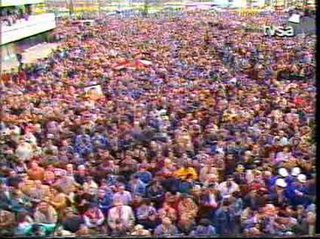 W
WOn 5 April 1992, in response to events all over Bosnia and Herzegovina 100,000 people of all nationalities turned out for a peace rally in Sarajevo. Serb snipers in the iconic Holiday Inn hotel under the control of the Serbian Democratic Party in the heart of Sarajevo opened fire on the crowd killing six people and wounding several more. Suada Dilberović and an ethnic Croat woman Olga Sučić were in the first rows, protesting on the Vrbanja bridge at the time. The bridge on which Sučić and Dilberović were killed was renamed in their honor. Six Serb snipers were arrested, but were exchanged when the Serbs threatened to kill the commandant of the Bosnian police academy who was captured the previous day, after the Serbs took over the academy and arrested him.
 W
WOperation Amanda was a United Nations Protection Force (UNPROFOR) mission conducted by Danish peacekeeping troops, with the aim of recovering an observation post, S01, belonging to 9th mech inf coy Nordbat 2 near Gradačac, Bosnia and Herzegovina, on October 25, 1994.
 W
WThe Banja Luka incident, on 28 February 1994, was an incident in which six Republika Srpska Air Force J-21 Jastreb single-seat light attack jets were engaged, and four of them shot down, by NATO warplanes from the United States Air Force. U.S. F-16 fighters southwest of Banja Luka, Bosnia and Herzegovina successfully engaged and destroyed several Bosnian Serb warplanes which had attacked a Bosnian factory, while suffering no casualties of their own. It marked the first active combat action, air-to-air or otherwise, in NATO's history.
 W
WBosfam is a non-governmental organization that provides psychosocial and economic assistance to women affected by the Bosnian war of 1992-1995. It was founded in May 1995 by women participating in an Oxfam GB psycho-social 'radionice' project to support internally displaced Bosnian women. In May 1995 Oxfam deployed one of its national staff members, Munira Beba Hadzic, to coordinate and support the establishment of a local NGO out of the successful EU funded women's support project. Oxfam also supported Ms Hadzic to travel to the UN Beijing women's conference in 1995.
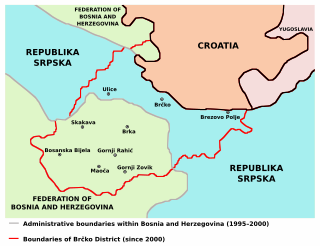 W
WThe Brčko corridor is a name used for a narrow strip of land along the southern bank of the Sava river that connected eastern and western part of the Republika Srpska from 1992 to 2000. It was created in 1992, after military Operation Corridor and was an important military and civil supply line for western parts of the Republika Srpska and Republic of Serbian Krajina during the Bosnian and Croatian war. After the Dayton Agreement was signed in 1995, the corridor remained within Republika Srpska, but subsequent international arbitration assigned this territory to a newly formed Brčko District, that became a territorial condominium shared between the Republika Srpska and the Federation of Bosnia and Herzegovina.
 W
WThe Croat–Bosniak War was a conflict between the Republic of Bosnia and Herzegovina and the self-proclaimed Croatian Republic of Herzeg-Bosnia, supported by Croatia, that lasted from 18 October 1992 to 23 February 1994. It is often referred to as a "war within a war" because it was part of the larger Bosnian War. In the beginning, Bosniaks and Croats fought in an alliance against the Yugoslav People's Army (JNA) and the Army of Republika Srpska (VRS). By the end of 1992, however, tensions between Bosniaks and Croats increased. The first armed incidents between them occurred in October 1992 in central Bosnia. Their military alliance held out until early 1993 when their cooperation fell apart and the two former allies engaged in open conflict.
 W
WThe Croatian Republic of Herzeg-Bosnia was an unrecognised geopolitical entity and proto-state in Bosnia and Herzegovina. It was proclaimed on 18 November 1991 under the name Croatian Community of Herzeg-Bosnia as a "political, cultural, economic and territorial whole" in the territory of Bosnia and Herzegovina.
 W
WThe General Framework Agreement for Peace in Bosnia and Herzegovina, also known as the Dayton Agreement or the Dayton Accords, is the peace agreement reached at Wright-Patterson Air Force Base near Dayton, Ohio, United States, on 1 November 1995, and formally signed in Paris, on 14 December 1995. These accords put an end to the 3 1⁄2-year-long Bosnian War, one of the Yugoslav Wars.
 W
WDead Winter Dead is the ninth studio album by the American heavy metal band Savatage, released in 1995. It is a concept album, dealing with a Serb boy and a Muslim girl who fall in love. The story of the album also focused on the Bosnian War, which was ongoing at the time.
 W
WOperation Deliberate Force was a sustained air campaign conducted by the North Atlantic Treaty Organisation (NATO), in concert with the United Nations Protection Force (UNPROFOR) ground operations, to undermine the military capability of the Army of Republika Srpska (VRS), which had threatened and attacked UN-designated "safe areas" in Bosnia and Herzegovina during the Bosnian War with the Srebrenica and Markale massacres, precipitating the intervention. The shelling of the Sarajevo market place on 28 August 1995 by the VRS is considered to be the immediate instigating factor behind NATO's decision to launch the operation.
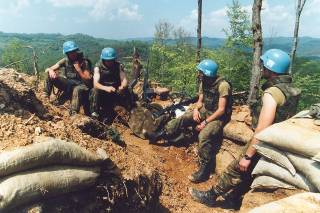 W
WDutchbat was a Dutch battalion under the command of the United Nations in operation United Nations Protection Force (UNPROFOR). It was hastily formed out of the emerging Air Mobile Brigade of the Royal Netherlands Armed Forces between February 1994 and November 1995 to participate in peacekeeping operations in the former Yugoslavia. It was tasked to execute United Nations Security Council Resolution 819 in the Bosniak Muslim enclaves and the designated UN "safe zone" of Srebrenica during the Bosnian War.
 W
WThe Exodus of Sarajevo Serbs refers to the migration of ethnic Serbs from Sarajevo, the capital of Bosnia and Herzegovina, between January and March 1996 after the Dayton Agreement that concluded the Bosnian War (1992–95).
 W
WThe Inter-Services Intelligence (ISI) intelligence agency of Pakistan allegedly ran an active military intelligence program during the Bosnian War which started in 1992 lasting until 1995. Allegedly executed and supervised by General Javed Nasir, the program distributed and coordinated the systematic supply of arms to ARBiH during the war. The ISI Bosnian contingent was organized with financial assistance provided by Saudi Arabia, according to the British historian Mark Curtis.
 W
WOperation Jackal, also known as Operation June Dawns, was an offensive of the Bosnian War fought between a combined Croatian Army (HV) and Croatian Defence Council (HVO) army against the Army of Republika Srpska (VRS) from 7–26 June 1992. The offensive was a Croatian pre-emptive strike against the VRS, a Bosnian Serb military formed in May 1992 from Yugoslav People's Army (JNA) units that were stationed in Bosnia and Herzegovina. The HV concluded that the JNA offensive operations of April and May 1992, resulting in the capture of Kupres and much of the Neretva River valley south of Mostar, were aimed at capturing or threatening the Croatian Port of Ploče and possibly Split. To counter this threat, the Croatian leadership deployed the HV, under the command of General Janko Bobetko, to the "Southern Front" including the area in which Operation Jackal was to be conducted.
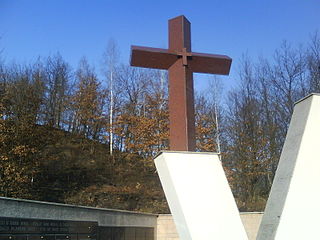 W
WThe Križančevo selo massacre occurred in Križančevo selo, a hamlet in the Lašva Valley in central Bosnia, where at least 14 Croat POWs and civilians were killed during an attack by the Army of the Republic of Bosnia and Herzegovina (ARBiH) on Croatian Defence Council (HVO) positions on 22 December 1993.
 W
WThe Battle of Kupres was a battle of the Bosnian War, fought between the Bosnian Croat Territorial Defence Force supported by the Croatian Army troops on one side and the Yugoslav People's Army, augmented by the Bosnian Serb TO on the other at the Kupres Plateau, on 3–11 April 1992. During the fighting on 8 April, the Bosnian Croat TO was reorganised as the Croatian Defence Council. The objective of the battle was to control the strategic Kupres Plateau, a major supply route.
 W
WThe Battle of Kupres was a battle of the Bosnian War, fought between the Army of the Republic of Bosnia and Herzegovina (ARBiH) and the Croatian Defence Council (HVO) on one side and the Army of Republika Srpska (VRS) on the other from 20 October to 3 November 1994. It marks the first tangible evidence of the Bosniak–Croat alliance set out in the Washington Agreement of March 1994, brokered by the United States to end the Croat–Bosniak War fought between the ARBiH and the HVO in Bosnia and Herzegovina. The ARBiH and the HVO were not coordinated at first, rather they launched separate operations aimed at capture of Kupres.
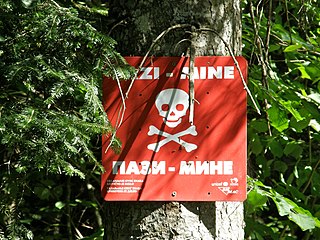 W
WLand mine contamination in Bosnia and Herzegovina is a serious after effect of the Bosnian War which raged from 1992 until 1995. During this time period, all 3 conflicting factions have planted land mines near the current-day political entity borders, and as a result the country has had the most severe land mine problems in the world.
 W
WOperation Winter '94 was a joint military offensive of the Croatian Army (HV) and the Croatian Defence Council (HVO) fought in southwestern Bosnia and Herzegovina between 29 November and 24 December 1994. The operation formed part of the Croatian War of Independence and the Bosnian War fought between Bosnia and Herzegovina, Croatia and two unrecognized para-states proclaimed by Croatian Serbs and Bosnian Serbs. Both para-states were supported by the Yugoslav People's Army (JNA) and Serbia. The JNA pulled out in 1992, but transferred much of its equipment to the Bosnian Serb and Croatian Serb forces as it withdrew.
 W
WOperation Winter '94 was a joint military offensive of the Croatian Army (HV) and the Croatian Defence Council (HVO) fought in southwestern Bosnia and Herzegovina between 29 November and 24 December 1994. The operation formed part of the Croatian War of Independence and the Bosnian War fought between Bosnia and Herzegovina, Croatia and two unrecognized para-states proclaimed by Croatian Serbs and Bosnian Serbs. Both para-states were supported by the Yugoslav People's Army (JNA) and Serbia. The JNA pulled out in 1992, but transferred much of its equipment to the Bosnian Serb and Croatian Serb forces as it withdrew.
 W
WOperation Mistral 2, officially codenamed Operation Maestral 2, was a Croatian Army (HV) and Croatian Defence Council (HVO) offensive in western Bosnia and Herzegovina on 8–15 September 1995 as part of the Bosnian War. Its objective was to create a security buffer between Croatia and positions held by the Bosnian Serb Army of Republika Srpska (VRS) and to put the largest Bosnian Serb-held city, Banja Luka, in jeopardy by capturing the towns of Jajce, Šipovo and Drvar. The combined HV and HVO forces were under the overall command of HV Major General Ante Gotovina.
 W
WThe Siege of Mostar was fought during the Bosnian War first in 1992 and then again later in 1993 to 1994. Initially lasting between April 1992 and June 1992, it involved the Croatian Defence Council (HVO) and the Army of the Republic of Bosnia and Herzegovina (ARBiH) fighting against the Serb-dominated Yugoslav People's Army (JNA) after Bosnia and Herzegovina declared its independence from Yugoslavia. That phase ended in June 1992 after the success of Operation Jackal, launched by the Croatian Army (HV) and HVO. As a result of the first siege around 90,000 residents of Mostar fled and numerous religious buildings, cultural institutions, and bridges were damaged or destroyed.
 W
WThe NATO intervention in Bosnia and Herzegovina was a series of actions undertaken by NATO whose stated aim was to establish long-term peace during and after the Bosnian War. NATO's intervention began as largely political and symbolic, but gradually expanded to include large-scale air operations and the deployment of approximately 60,000 soldiers under Operation Joint Endeavor.
 W
WOperation Grapple was the codeword used to cover UK defence operations in support of the UN peacekeeping missions in the former Yugoslavia ; including the deployment of British forces in Bosnia and Croatia from October 1992 until December 1995 as part of the United Nations Protection Force (UNPROFOR). UNPROFOR would eventually hand over the peacekeeping mission in Bosnia to NATO's Implementation Force (IFOR) in winter 1995. The British participation in the IFOR was called Operation Resolute; the whole NATO mission was called Operation Joint Endeavour. The IFOR mission would last approximately a year, before it transitioned to the follow-on Stabilisation Force in Bosnia and Herzegovina (SFOR).
 W
WOperation Sana was the final military offensive of the Army of the Republic of Bosnia and Herzegovina in western Bosnia and Herzegovina and the last major battle of the Bosnian War. It was launched from the area of Bihać on 13 September 1995, against the Army of Republika Srpska, and involved advances towards Bosanski Petrovac, Sanski Most and Bosanska Krupa. At the same time, the Croatian Army and the Croatian Defence Council were engaging the VRS in Operation Maestral 2 further to the southeast. After an initial 70-kilometre (43 mi) advance, VRS reinforcements managed to stop the ARBiH short of Sanski Most and Novi Grad, and reversed some of the ARBiH's territorial gains in a counterattack. After a part of the ARBiH 5th Corps was threatened with defeat around the town of Ključ, the ARBiH requested assistance from the HV.
 W
WOperation Tiger 94 was a military action in the summer of 1994, by the Army of the Republic of Bosnia and Herzegovina (ARBiH) against the Bosnian autonomous zone of the Autonomous Province of Western Bosnia, its leader Fikret Abdić and his Serbian backers the Army of the Republic of Serb Krajina (SVK), and the Army of Republika Srpska (VRS). The battle was a huge success for the ARBiH, which was able to rout Abdić's forces and occupy the territory of Western Bosnia. Fikret Abdić was able to recapture the territory in December 1994 in Operation Spider.
 W
WThe Siege of Srebrenica was a three-year siege of the town of Srebrenica in eastern Bosnia and Herzegovina which lasted from April 1992 to July 1995 during the Bosnian War. Initially assaulted by the Yugoslav People's Army (JNA) and the Serbian Volunteer Guard (SDG), the town was encircled by the Army of Republika Srpska (VRS) in May 1992, starting a brutal siege which was to last for the majority of the Bosnian War. In June 1995, the commander of the Army of the Republic of Bosnia and Herzegovina (ARBiH) in the enclave, Naser Orić, left Srebrenica and fled to the town of Tuzla. He was subsequently replaced by his deputy, Major Ramiz Bećirović.
 W
WA Bosniak republic, or "Bosniak entity", was proposed during the Bosnian War when plans for the partition of Bosnia and Herzegovina were made. [proposed by who?] It would either be established as one of three ethnic states in a loose confederation, or as an independent "Muslim state" in the area controlled by the Bosnian Army, as proposed by Islamists. Thus, the Bosniak-inhabited territories or Bosnian Army-controlled area would become a Bosniak state, as Republika Srpska was for the Bosnian Serbs and Herzeg-Bosnia for the Bosnian Croats. The failed 1992 Serb–Croat Graz agreement would see a small Bosniak buffer state, pejoratively called "Alija's Pashaluk" on a map displayed during the discussions. The Owen-Stoltenberg plan would give Bosniaks 30% of territory, including ca. 65% of the Bosniak population. In February 1994, the Party of Democratic Action (SDA) proposed a Bosniak state in which Serbs and Croats would be national minorities. The Dayton Agreement ended the war and created the federal republic of Bosnia and Herzegovina (BiH), made up of two entities, the Bosniak and Croat-inhabited Federation of Bosnia and Herzegovina (FBiH), and the Serb-inhabited Republika Srpska (RS). As noted by international relations expert Niels van Willigen: "Whereas the Bosnian Croats and Bosnian Serbs could identify themselves with Croatia or Serbia respectively, the absence of a Bosniak state made the Bosniaks firmly committed to Bosnia as a single political entity."
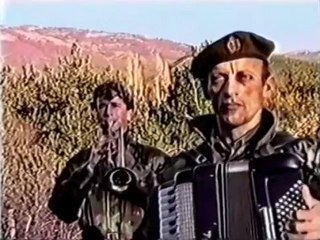 W
WRemove Kebab is a phrase that originated in the online community surrounding a Serb nationalist and anti-Muslim propaganda music video from the Yugoslav Wars. The phrase has spread globally amongst Neo-Nazi groups and the alt-right as a meme which references and advocates for the ethnic cleansing of Muslims.
 W
WThe Republic of Bosnia and Herzegovina was a state in Southeastern Europe, existing from 1992 to 1995. It is the direct legal predecessor to the modern-day state of Bosnia and Herzegovina.
 W
WScandinavian Airlines System Flight 347 was a scheduled domestic flight which, on 3 November 1994, was hijacked shortly after take-off. The flight, from Bardufoss Airport via Bodø Airport to Oslo Airport, Fornebu in Norway, was operated by a McDonnell Douglas MD-82 belonging to Scandinavian Airlines System (SAS). The hijacker was Haris Keč, a Bosnian living in Norway, who made demands that Norwegian authorities help to stop the humanitarian suffering in his home country caused by the Bosnian War. No one was injured in the incident.
 W
WOperation Sky Monitor was a NATO mission to monitor unauthorized flights in the airspace of Bosnia and Herzegovina during the Bosnian War. The operation began in response to United Nations Security Council Resolution 781, which established a ban on the use of military aircraft in Bosnian airspace, and requested the aid of member states in monitoring compliance. Beginning on October 16, 1992, NATO monitored violations of the no-fly zone using E-3 Sentry NAEW aircraft based in Germany, Italy, Greece, and the United Kingdom. The operation documented more than 500 violations of the no-fly zone by April 1993. In response to this high volume of unauthorized flights, the Security Council passed Resolution 816, which authorized NATO to enforce the no-fly zone, and engage violators. In response, NATO deactivated Sky Monitor on April 12, 1993, transferring its forces to the newly established Operation Deny Flight.
 W
WOperation Southern Move was the final Croatian Army (HV) and Croatian Defence Council (HVO) offensive of the Bosnian War. It took place in western Bosnia and Herzegovina on 8–11 October 1995. Its goal was to help the Army of the Republic of Bosnia and Herzegovina (ARBiH) whose positions around the town of Ključ, captured by them during Operation Sana, were endangered by a counteroffensive by the Army of Republika Srpska (VRS). The objectives of Operation Southern Move included the capture of the town of Mrkonjić Grad and positions on the Manjača Mountain which would allow the HV and the HVO to directly threaten Banja Luka, the largest city controlled by Bosnian Serbs. Finally, the offensive was also aimed at capturing the Bočac Hydroelectric Power Station, the last significant source of electricity under VRS control in western Bosnia and Herzegovina. The combined HV and HVO forces were under the overall command of HV Major General Ante Gotovina.
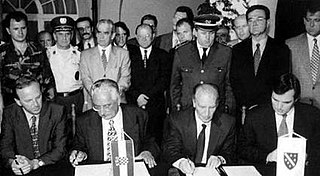 W
WThe Split Agreement or Split Declaration was a mutual defence agreement between Croatia, the Republic of Bosnia and Herzegovina and the Federation of Bosnia and Herzegovina, signed in Split, Croatia on 22 July 1995. It called on the Croatian Army (HV) to intervene militarily in Bosnia and Herzegovina, primarily in relieving the siege of Bihać.
 W
WThe Srebrenica Genocide Memorial, officially known as the Srebrenica–Potočari Memorial and Cemetery for the Victims of the 1995 Genocide, is the memorial-cemetery complex in Srebrenica set up to honour the victims of the 1995 Srebrenica massacre. The victims—at least 8,372 of them—were mainly males, mostly Muslim Bosniaks and some Catholic Croats.
 W
WThe Stabilisation Force in Bosnia and Herzegovina (SFOR) was a NATO-led multinational peacekeeping force deployed to Bosnia and Herzegovina after the Bosnian war. Although SFOR was led by NATO, several non-NATO countries contributed troops. It was replaced by EUFOR Althea in December 2004.
 W
WOperation Storm was the last major battle of the Croatian War of Independence and a major factor in the outcome of the Bosnian War. It was a decisive victory for the Croatian Army (HV), which attacked across a 630-kilometre (390 mi) front against the self-declared proto-state Republic of Serbian Krajina (RSK), and a strategic victory for the Army of the Republic of Bosnia and Herzegovina (ARBiH). The HV was supported by the Croatian special police advancing from the Velebit Mountain, and the ARBiH located in the Bihać pocket, in the Army of the Republic of Serbian Krajina's (ARSK) rear. The battle, launched to restore Croatian control of 10,400 square kilometres of territory, representing 18.4% of the territory it claimed, and Bosnian control of Western Bosnia, was the largest European land battle since the Second World War. Operation Storm commenced at dawn on 4 August 1995 and was declared complete on the evening of 7 August, despite significant mopping-up operations against pockets of resistance lasting until 14 August.
 W
WThe Croat–Bosniak War was a conflict between the Republic of Bosnia and Herzegovina and the Croatian Community of Herzeg-Bosnia, supported by Croatia, that lasted from 19 June 1992 – 23 February 1994. The Croat-Bosniak War is often referred to as a "war within a war" because it was part of the larger Bosnian War.
 W
WThe Prosecutor v. Ratko Mladić was a war crimes trial before the International Criminal Tribunal for the former Yugoslavia (ICTY) in The Hague, Netherlands, concerning crimes committed during the Bosnian War by Ratko Mladić in his role as a general in the Yugoslav People's Army and the Chief of Staff of the Army of Republika Srpska.
 W
WTudjmanism is a form of Croatian nationalism. Franjo Tuđman defined it as non-Communist nationalism with "re-examined Croatian history". According to Croatian historian Ivo Banac, Tudjmanism unites all forms of the Croatian anti-liberalism, that is Croatian fascism and the Croatian communism. Croatian political scientist Slaven Ravlić defines Tuđmanism to be the name both for an ideology and for a regime. According to Ravlić, the ideology contains elements of deification of the Croatian people started by Ante Starčević, a continuation of the 20th-century conservative tradition that rejects liberal democracy, and a mix of ideas represented by neoconservatism. The resulting regime was authoritarian, it created a form of crony capitalism, and engaged in the creation of an ideological hegemony.
 W
WOn 23 September 1997, the Irish rock band U2 held a concert at Koševo Stadium in Sarajevo, Bosnia and Herzegovina, as part of the group's PopMart Tour. They were the first major artist to hold a concert in the city after the end of the Bosnian War. Approximately 45,000 fans attended the show.
 W
WOperation Una was a military offensive conducted by the Croatian Army against the Army of Republika Srpska in western Bosnia and Herzegovina on 18–19 September 1995, during the Bosnian War. The operation entailed a crossing of the Una and Sava rivers to establish bridgeheads at Novi Grad, Bosanska Dubica, Bosanska Kostajnica and opposite Jasenovac to allow for a subsequent advance towards Prijedor and Banja Luka.
 W
WUnited Nations Security Council resolution 780, adopted unanimously on 6 October 1992, after reaffirming Resolution 713 (1991) and subsequent resolutions on the topic, the Council expressed its concern at the continued "widespread violations of international humanitarian law" in Bosnia and Herzegovina and authorised the Secretary-General Boutros Boutros-Ghali to establish a Commission of Experts to examine and analyse the information submitted pursuant to Resolution 771 (1992) on violations of the Geneva Conventions in the region.
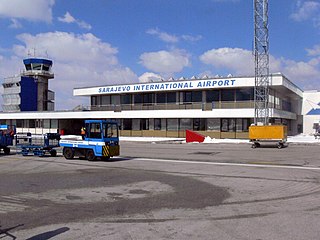 W
WUnited Nations Security Council resolution 781, adopted on 9 October 1992, after reaffirming Resolution 713 (1991) and all subsequent resolutions on the situation in the former Yugoslavia, the Council decided to impose a ban on military flights in the airspace over Bosnia and Herzegovina, acting in accordance with the provisions set out in Resolution 770 (1992).
 W
WUnited Nations Security Council resolution 786, adopted unanimously on 10 November 1992, after reaffirming Resolution 781 (1992), the Council approved a recommendation by the Secretary-General Boutros Boutros-Ghali to increase the strength of the United Nations Protection Force (UNPROFOR) in Bosnia and Herzegovina by 75 observers to monitor the ban on military flights over the country.
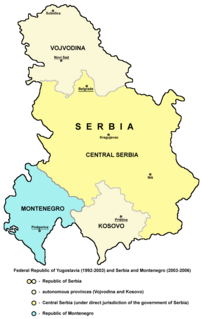 W
WUnited Nations Security Council resolution 787, adopted on 16 November 1992, after reaffirming Resolution 713 (1991) and all subsequent resolutions on the topic, the Council called upon the parties in Bosnia and Herzegovina to consider the draft outline constitution as a basis for negotiating a political settlement of the conflict in the country, and went on to impose further international sanctions on the Federal Republic of Yugoslavia.
 W
WUnited Nations Security Council resolution 795, adopted on 11 December 1992, after expressing concern about possible developments which could undermine confidence and stability in the former Yugoslav Republic of Macedonia and welcoming the Organization for Security and Co-operation in Europe (OSCE) mission in Macedonia, the Council recalled Chapter VIII of the United Nations Charter and authorised the Secretary-General Boutros Boutros-Ghali to deploy a presence of the United Nations Protection Force (UNPROFOR) in the border areas of Macedonia.
 W
WUnited Nations Security Council resolution 798, adopted unanimously on 18 December 1992, after reaffirming 770 (1992) and 771 (1992) and supporting an initiative by the European Council.The Council condemned reports of the massive, organized and systematic detention and rape of women, in particular Muslim women, in Bosnia and Herzegovina during the Bosnian War.
 W
WUnited Nations Security Council resolution 819, adopted unanimously on 16 April 1993, after reaffirming resolutions 713 (1991) and all (1992) subsequent resolutions, the Council expressed concern at the actions of Bosnian Serb paramilitary units in towns and villages in eastern Bosnia and Herzegovina, including attacks on civilians, the United Nations Protection Force and disruption to humanitarian aid convoys. The resolution marked the UN's first civilian "safe area" being declared; it failed to prevent the Srebrenica massacre.
 W
WUnited Nations Security Council resolution 820, adopted on 17 April 1993, after reaffirming all previous resolutions on the topic for a lasting peace settlement in Bosnia and Herzegovina and the region, the Council discussed the peace plan for Bosnia and Herzegovina and comprehensive steps to ensure its implementation.
 W
WThe Battle of Vozuća was an attack by the 3rd Corps of the Army of the Republic of Bosnia and Herzegovina on 10 September 1995 against the strategically important village of Vozuća, in the municipality of Zavidovići during the Bosnian War. This area was held by rebel Bosnian Serb forces since 1992, which had committed war crimes against 21 Bosniak civilians.
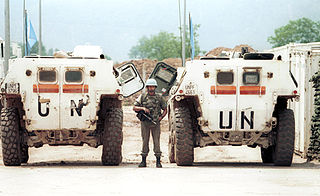 W
WThe Battle of Vrbanja Bridge was an armed confrontation which occurred on 27 May 1995 between United Nations (UN) peacekeepers from the French Army and elements of the Bosnian Serb Army of Republika Srpska (VRS). It began after the VRS seized French-manned United Nations Protection Force (UNPROFOR) observation posts on both ends of the Vrbanja Bridge crossing of the Miljacka river in Sarajevo, Bosnia and Herzegovina during the Bosnian War. Upon seizing the bridge, the VRS took the French peacekeepers hostage.
 W
WThe Washington Agreement was a ceasefire agreement between the Republic of Bosnia and Herzegovina and the Croatian Republic of Herzeg-Bosnia, signed in Washington on 18 March 1994 and Vienna. It was signed by Bosnian Prime Minister Haris Silajdžić, Croatian Foreign Minister Mate Granić and President of Herzeg-Bosnia Krešimir Zubak. Under the agreement, the combined territory held by the Croat and Bosnian government forces was divided into ten autonomous cantons, establishing the Federation of Bosnia and Herzegovina. The cantonal system was selected to prevent dominance by one ethnic group over another.
 W
WThe Autonomous Province of Western Bosnia, or Western Bosnia, was a small unrecognised state that existed in the northwest of Bosnia and Herzegovina between 1993 and 1995. It consisted of the town of Velika Kladuša, its capital, as well as a few nearby villages. It was proclaimed as a result of secessionist politics by former Bosnian President Fikret Abdić against the central government of Alija Izetbegovic during the Bosnian War. For a short time in 1995, it was known as the Republic of Western Bosnia.